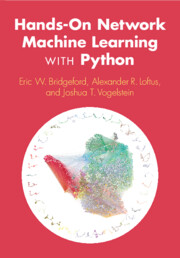Refine search
Actions for selected content:
48532 results in Computer Science
1 - Metacognitive AI
- from Part I - Introduction
-
-
- Book:
- Metacognitive Artificial Intelligence
- Published online:
- 08 September 2025
- Print publication:
- 25 September 2025, pp 3-22
-
- Chapter
- Export citation
Errata to “Isomorphism theorems between models of mixed choice,” fixes and consequences
-
- Journal:
- Mathematical Structures in Computer Science / Volume 35 / 2025
- Published online by Cambridge University Press:
- 24 September 2025, e23
-
- Article
- Export citation
Limits and colimits in synthetic
 $\infty$-categories
$\infty$-categories
-
- Journal:
- Mathematical Structures in Computer Science / Volume 35 / 2025
- Published online by Cambridge University Press:
- 24 September 2025, e24
-
- Article
-
- You have access
- Open access
- HTML
- Export citation
The flow must go on: Evaluating the impact of a collocation writing assistant on self-revision
-
- Journal:
- ReCALL , First View
- Published online by Cambridge University Press:
- 24 September 2025, pp. 1-18
-
- Article
-
- You have access
- Open access
- HTML
- Export citation
Human–machine coupling dynamics modeling and adaptive admittance control of lower limb rehabilitation robot
-
- Journal:
- Robotica , First View
- Published online by Cambridge University Press:
- 24 September 2025, pp. 1-23
-
- Article
- Export citation
Kinematics, singularity, and workspace analysis of a balance rehabilitation parallel manipulator
-
- Journal:
- Robotica , First View
- Published online by Cambridge University Press:
- 24 September 2025, pp. 1-19
-
- Article
- Export citation

Hands-On Network Machine Learning with Python
-
- Published online:
- 23 September 2025
- Print publication:
- 18 September 2025
Choice trees: Representing and reasoning about nondeterministic, recursive, and impure programs in Rocq
- Part of
-
- Journal:
- Journal of Functional Programming / Volume 35 / 2025
- Published online by Cambridge University Press:
- 23 September 2025, e21
-
- Article
-
- You have access
- Open access
- HTML
- Export citation
SATISFACTION IS NOT ABSOLUTE
- Part of
-
- Journal:
- The Review of Symbolic Logic , First View
- Published online by Cambridge University Press:
- 23 September 2025, pp. 1-28
-
- Article
-
- You have access
- Open access
- HTML
- Export citation
Precipitation prediction over the upper Indus Basin from large-scale circulation patterns using Gaussian processes
-
- Journal:
- Environmental Data Science / Volume 4 / 2025
- Published online by Cambridge University Press:
- 23 September 2025, e46
-
- Article
-
- You have access
- Open access
- HTML
- Export citation
Data visualization tool for a fairer geography of refugee protection in Europe
- Part of
-
- Journal:
- Data & Policy / Volume 7 / 2025
- Published online by Cambridge University Press:
- 22 September 2025, e63
-
- Article
-
- You have access
- Open access
- HTML
- Export citation
Adversarial natural language processing: overview, challenges, and policy implications
-
- Journal:
- Data & Policy / Volume 7 / 2025
- Published online by Cambridge University Press:
- 22 September 2025, e64
-
- Article
-
- You have access
- Open access
- HTML
- Export citation
Leveraging AI in peace processes: A framework for digital dialogues
- Part of
-
- Journal:
- Data & Policy / Volume 7 / 2025
- Published online by Cambridge University Press:
- 22 September 2025, e65
-
- Article
-
- You have access
- Open access
- HTML
- Export citation
Memory of the multitude and representation in AI-generated images of war
- Part of
-
- Journal:
- Memory, Mind & Media / Volume 4 / 2025
- Published online by Cambridge University Press:
- 22 September 2025, e14
-
- Article
-
- You have access
- Open access
- HTML
- Export citation

Human-AI Interaction and Collaboration
-
- Published online:
- 19 September 2025
- Print publication:
- 09 October 2025
Decoding the digital thread digitalization approach for product design and development: benefits, challenges, and extensions
-
- Article
-
- You have access
- Open access
- HTML
- Export citation
Comparing the sets of volume polynomials and Lorentzian polynomials
- Part of
-
- Journal:
- Combinatorics, Probability and Computing , First View
- Published online by Cambridge University Press:
- 19 September 2025, pp. 1-14
-
- Article
-
- You have access
- Open access
- HTML
- Export citation
From ‘wild west’ to ‘responsible’ AI testing ‘in-the-wild’: lessons from live facial recognition testing by law enforcement authorities in Europe
-
- Journal:
- Data & Policy / Volume 7 / 2025
- Published online by Cambridge University Press:
- 19 September 2025, e59
-
- Article
-
- You have access
- Open access
- HTML
- Export citation
Glauber dynamics for the hard-core model on bounded-degree
 $H$-free graphs
$H$-free graphs
- Part of
-
- Journal:
- Combinatorics, Probability and Computing , First View
- Published online by Cambridge University Press:
- 19 September 2025, pp. 1-12
-
- Article
-
- You have access
- Open access
- HTML
- Export citation
















































